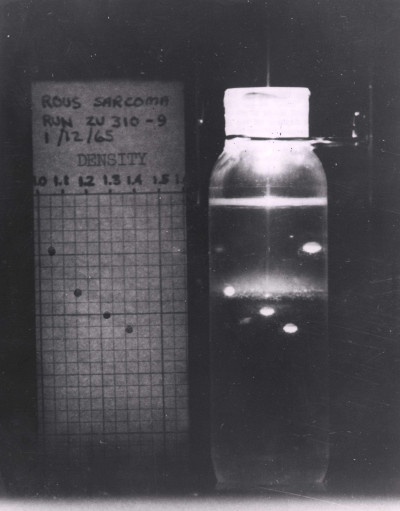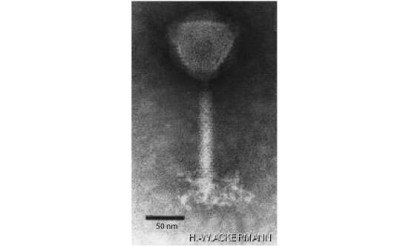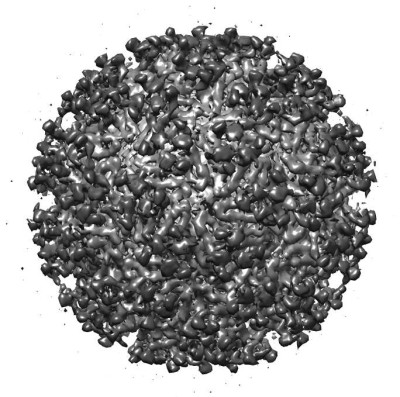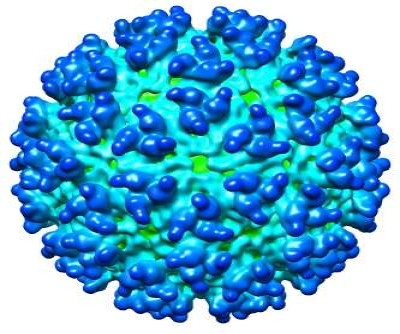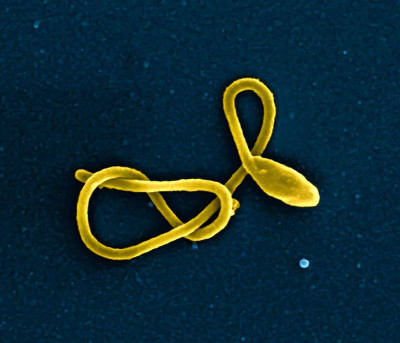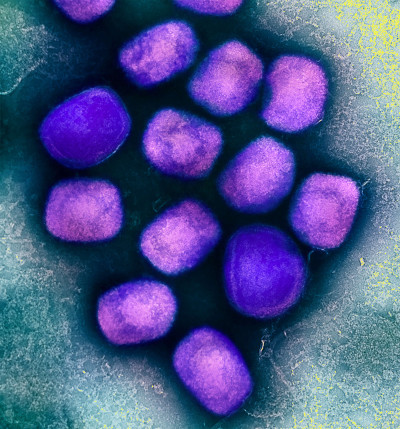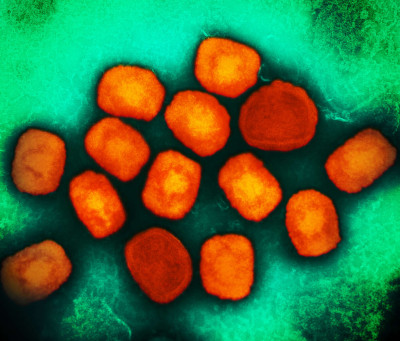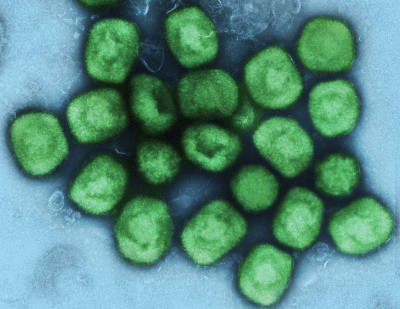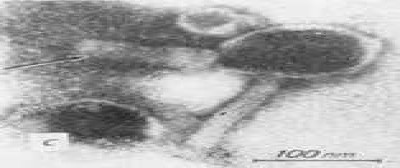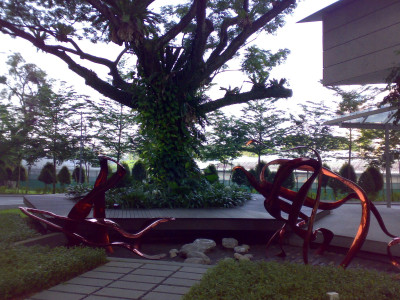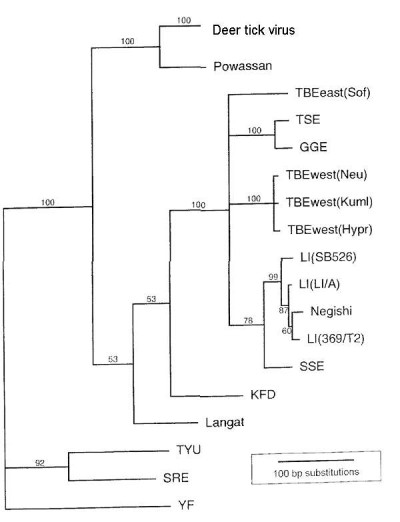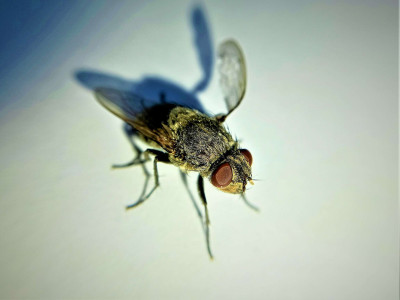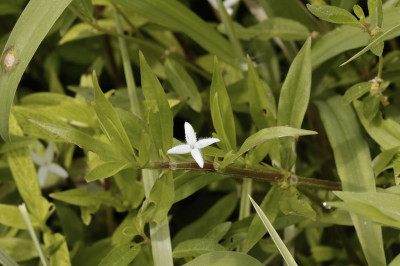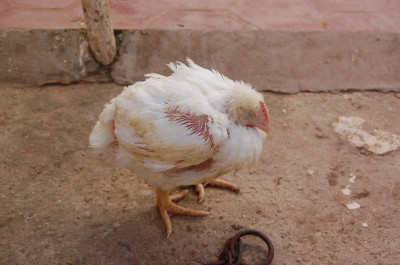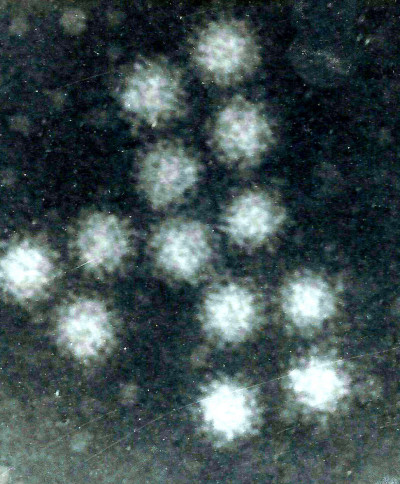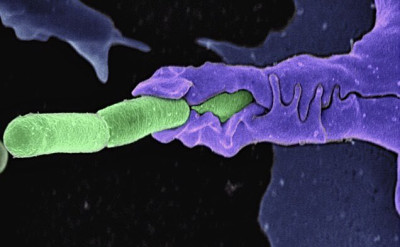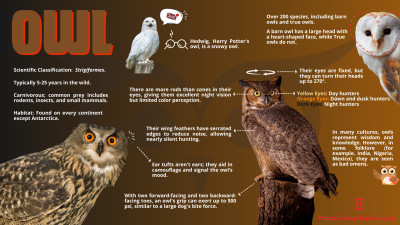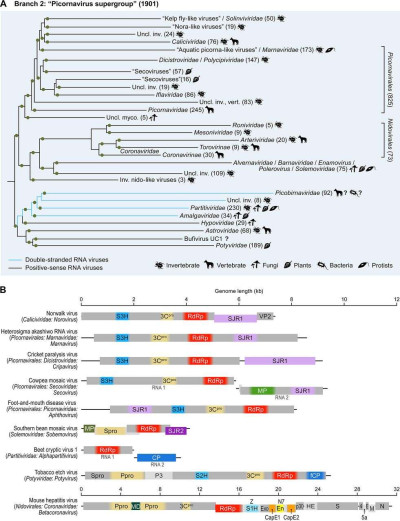The band recovery apparatus is one of a family of new instruments and equipment developed to attack the problems of concentrating, detecting and recovering virus particles in a high state of purity.
Wikimedia Commons, U.S. Department of Energy
02 Feb 2024
Electron microscopic image of a virion from the genus Okubovirus (formerly Spounalikevirus).
ViralZone, SIB Swiss Institute of Bioinformatics, Wikimedia Commons
01 Mar 2024
CryoEM reconstruction of the Everglades Virus. Electron Microscopy Data Bank (EMDB) entry EMD-5563.
Wikimedia Commons, A2-33
11 Mar 2024
Transmission electron micrographs of fathead minnow (FHM) cells infected by Frog virus 3 (FV3). Upper left and right panels show typical virus-infected cells with nuclei (N) showing evidence of chromatin condensation, well-defined viral assembly sites (AS); intracytoplasmic paracrystalline arrays (asterisk), and virions budding from the plasma membrane (arrow). Lower left panel shows a virus-infected cell in which virions are scattered throughout the cytoplasm. Lower right panel is an enlargement of a viral assembly site showing virions in various stages of assembly. Full (A4 and A5) and empty (A3) viral particles are shown as well as two possible intermediates (A1 and A2) and two aberrant forms (C and E). The inset indicates membranes (arrows), possible originating from the ER, that play a role in virion morphogenesis. [1]
Wikimedia Commons, Jancovich J.K., Qin Q., Zhang QY., Chinchar V.G; Gray M., Chinchar V.
14 Mar 2024
CryoEM model of western equine encephalitis virus, 12Å resolution. EMDB entry EMD-5210.
Wikimedia Commons, A2-33
15 Mar 2024
This scanning electron micrograph shows a single filamentous Ebola virus particle. Scientists supported by the NIH have discovered a set of powerful, broadly neutralizing antibodies in the blood of Ebola survivors.
Wikimedia Commons, NIH Image Gallery
02 Apr 2024
Colorized transmission electron micrograph of monkeypox virus particles (purple) cultivated and purified from cell culture. Image captured at the NIAID Integrated Research Facility (IRF) in Fort Detrick, Maryland.
Wikimedia Commons, NAID
07 Apr 2024
Colorized transmission electron micrograph of monkeypox virus particles (orange) cultivated and purified from cell culture. Image captured at the NIAID Integrated Research Facility (IRF) in Fort Detrick, Maryland.
Wikimedia Commons, NAID
08 Apr 2024
Colorized transmission electron micrograph of monkeypox virus particles (green) cultivated and purified from cell culture. Image captured at the NIAID Integrated Research Facility (IRF) in Fort Detrick, Maryland.
Wikimedia Commons, NAID
08 Apr 2024
Ultrastructure of phiKZ phage particles after a freezing and thawing procedure. The inner body coming out of the phiKZ particle disrupted by freezing and thawing (arrow).
Wikimedia Commons, Victor Krylov, Maria Bourkaltseva, Elena Pleteneva, Olga Shaburova, Sergey Krylov, Alexander Karaulov, Sergey Zhavoronok, Oxana Svitich, Vitaly Zverev
09 Apr 2024
Schematic of the genome organization, particle protein composition, and morphology of a newly discovered partitivirus of Rosellinia necatrix. (Left) Genome organization of a representative betapartitivirus, Rosellinia necatrix partitivirus 11 (RnPV11/W98). (Middle) SDS-PAGE analysis of purified preparations of RnPV11. Virus particles were purified from the mycelia of the W98 strain (lane RnPV11) and analyzed in 10% polyacrylamide gel electrophoresis. The arrow indicates the migration of RnPV11/W98 CP. A preparation was also obtained in parallel from virus-free W97 (VF). Protein size standards used (lane M, Precision Plus Protein Dual Color Standards) were purchased from Bio-Rad Laboratories, Inc., Hercules, CA, USA. (Right) Electron microscopy of RnPV11 virions. A purified virus preparation of RnPV11 was examined using a Hitachi electron microscope model H-7650. [1]
Paul Telengech, Sakae Hisano, Cyrus Mugambi, Kiwamu Hyodo, Juan Manuel Arjona-López, Carlos José López-Herrera, Satoko Kanematsu, Hideki Kondo, Nobuhiro Suzuki
18 Apr 2024
Sculpture "SARS Inhibited" by Mara G. Haseltine (2006), at Biopolis in One-North, Buona Vista, Singapore.
Wikimedia Commons, Mara G. Haseltine
23 Apr 2024
Maximum parsimony phylogram indicating the relationship of deer tick virus to other tick-borne encephalitis group viruses. Values above branches indicate bootstrapped confidence values. Branch lengths are proportional to percent similarity in sequence. TBE, tick borne encephalitis; TSE, Turkish sheep encephalitis; GGE, Greek goat encephalitis; LI, louping ill virus; SSE, Spanish sheep encephalitis; KFD, Kyasanur Forest disease virus; TYU, Tyuleniy virus; SRE, Saumarez Reef virus. The topology of the phylogram that was independently derived from NS-5 does not differ from that of env and is not presented.
Wikimedia Commons, Sam R. Telford III, Philip M. Armstrong, Paula Katavolos, Ivo Foppa, A. Sonia Olmeda Garcia, Mark L. Wilson, Andrew Spielman
23 Apr 2024
Cluster flies, scientifically known as 'Pollenia rudis,' are sizable black flies that tend to appear in homes during late fall to early spring. They bear a striking resemblance to house flies.
iNaturalist, Agapakis Georgios
11 May 2024
Diodia vein chlorosis virus primarily infects plants within the Diodia genus, particularly Diodia teres. Diodia species are herbaceous plants in the Rubiaceae family, and they are often considered weeds in agricultural and horticultural settings, particularly in warm climates.
iNaturalist
11 May 2024
The outbreak of poultry pox may be caused by both a viral and a bacterial infection.
Wikimedia Commons, Lucyin
11 May 2024
Thirteen noroviruses: an electron micrograph. Magnification approximately 200 times.
Wikimedia Commons, Graham Beards
28 May 2024
Under the electron microscope, an immune cell engulfs anthrax bacteria, showcasing the body's defense mechanisms. The macrophage extends arm-like pseudopodia to encircle and trap the rod-shaped bacteria, identified by their distinctive surface texture
08 Jul 2024
Owls are some of the most fascinating creatures in the animal kingdom! With their stealthy flight, powerful grip, and unique adaptations, they’ve earned a reputation as expert hunters.
Encyclopedia Editorial Office
18 Nov 2024
Branch 2 of the RNA virus RNA-dependent RNA polymerases (RdRps): “picornavirus supergroup” of the +RNA viruses expanded to include nidoviruses and two groups of dsRNA viruses, partitiviruses, and picobirnaviruses. (A) Phylogenetic tree of the virus RdRps showing ICTV accepted virus taxa and other major groups of viruses. Approximate numbers of distinct virus RdRps present in each branch are shown in parentheses. Symbols to the right of the parentheses summarize the presumed virus host spectrum of a lineage. Green dots represent well-supported (≥0.7) branches. Inv., viruses of invertebrates (many found in holobionts, making host assignment uncertain); myco., mycoviruses; Uncl., unclassified; vert., vertebrate. (B) Genome maps of a representative set of branch 2 viruses (drawn to scale) showing color-coded major conserved domains. Where a conserved domain comprises only a part of the larger protein, the rest of this protein is shown in light gray. The locations of such domains are approximated (indicated by fuzzy boundaries). 3Cpro, 3C chymotrypsin-like protease; CP, capsid protein; E, envelope protein; En, nidoviral uridylate-specific endoribonuclease (NendoU); Exo, 3′-to-5′ exoribonuclease domain; fCP, capsid protein forming filamentous virions; M, membrane protein; MD, macrodomain; MP, movement protein; MT, ribose-2-O-methyltransferase domain; N, nucleocapsid protein; N7, guanine-N7-methyltransferase; Ppro, papain-like protease; SJR1 and SJR2, single jelly-roll capsid proteins of type 1 and type 2; spike, spike protein; S1H, superfamily 1 helicase; S2H, superfamily 2 helicase; S3H, superfamily 3 helicase; VP2, virion protein 2; Z, Zn-finger domain; Spro, serine protease; P3, protein 3. Distinct hues of same color (e.g., green for MPs) are used to indicate cases where proteins that share analogous function are not homologous [1].
Wikimedia Commons, Yuri I. Wolf, Darius Kazlauskas, Jaime Iranzo, Adriana Lucía-Sanz, Jens H. Kuhn, Mart Krupovic, Valerian V. Dolja, Eugene V. Koonin
01 Feb 2024
 Encyclopedia
Encyclopedia
